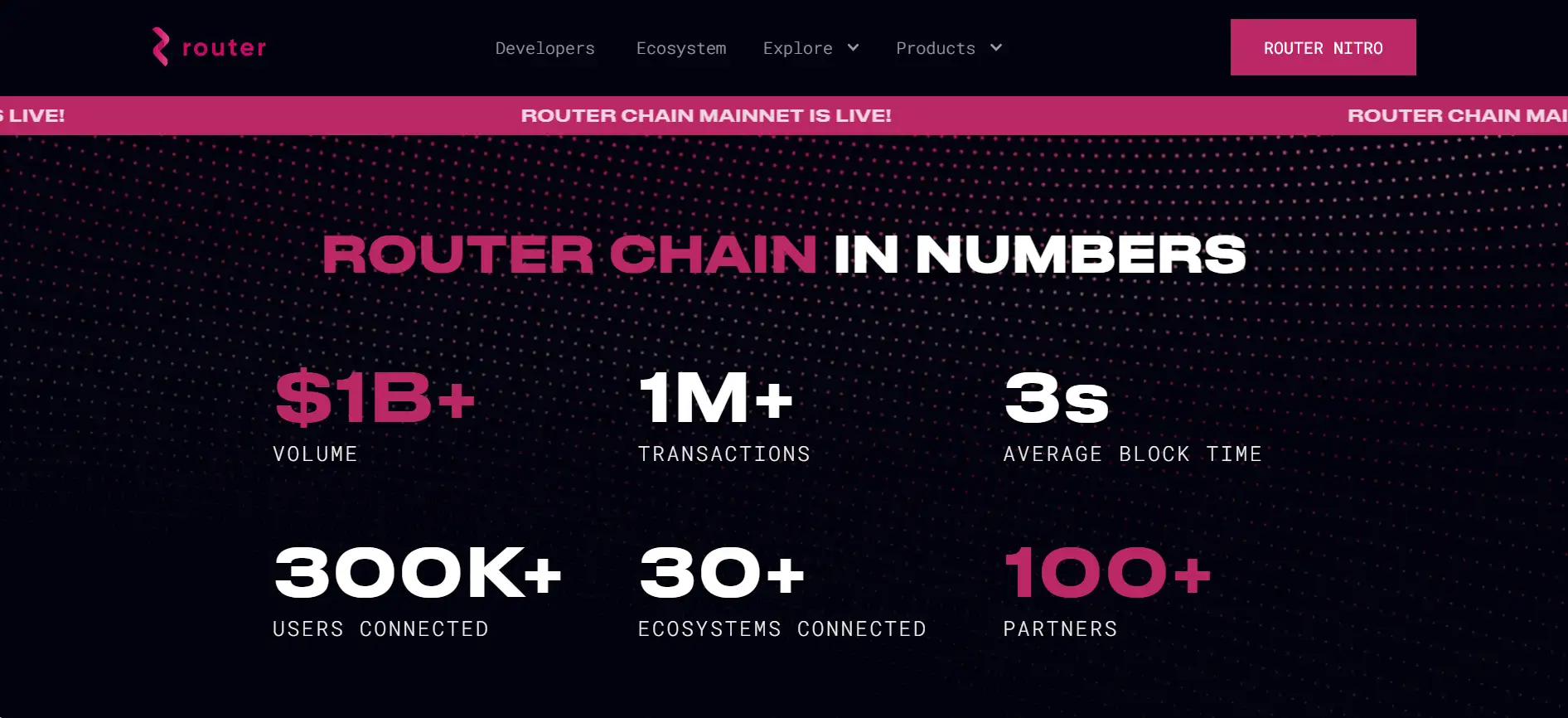About Router Protocol
Router Protocol is a pioneering infrastructure platform focused on enabling true chain abstraction across the blockchain ecosystem. Built on a custom Layer-1 blockchain utilizing Tendermint’s BFT consensus, Router Protocol allows developers to build decentralized applications (dApps) that can read, modify, and interact with states on any connected blockchain, offering a seamless cross-chain user experience.
Through products like Router Chain, Router Nitro, and Router CCIF, Router Protocol offers a highly scalable and customizable environment for cross-chain asset transfers, dApp development, and DeFi innovations. With support for over 30 blockchain ecosystems and over 1 million transactions processed, Router Protocol is building the foundational layer for a more interoperable and efficient decentralized future.
Router Protocol addresses one of the most significant challenges in Web3: blockchain interoperability. Its flagship product, the Router Chain, offers a highly secure, Proof-of-Stake blockchain built using Cosmos SDK and designed specifically for cross-chain communication. Unlike isolated blockchains, Router Protocol enables applications to operate across multiple ecosystems, breaking down barriers between networks like Ethereum, Solana, Polygon, and Arbitrum.
A key offering is Router Nitro, an ultra-low latency bridge that supports asset swaps across 30+ blockchains with high throughput and minimal transaction times. In contrast to competitors like Synapse Protocol and Celer Network, which also offer bridging services, Router Protocol stands out through its intent-based architecture, deeper customizability for dApps, and full chain abstraction at the protocol level.
Developers can leverage Router CrossTalk to easily transform single-chain or multi-chain dApps into true cross-chain applications. Unlike solutions such as Wormhole or Axelar, which primarily focus on asset bridging or messaging, Router provides an entire programmable environment to build complex cross-chain workflows with minimal code changes.
In addition, Router Protocol supports omnichain asset deployments through its xERC20-compatible framework, empowering users to build seamless omnichain stablecoins, money markets, airdrop aggregators, and cross-chain DeFi strategies. Through its open-source Router Intent Store and upcoming innovations like Router Pay (ISA mechanism), Router Protocol continues to push the boundaries of what decentralized applications can achieve in an increasingly multi-chain world.
Router Protocol provides developers and users with a robust suite of benefits and features:
- Chain Abstraction Layer: Build dApps that operate across multiple chains without separate deployments.
- Cross-Chain Asset Swaps: Swap assets across 30+ ecosystems with Router Nitro in seconds.
- Stateful and Stateless Communication: Leverage Router CrossTalk to transfer smart contract states across chains.
- Omnichain Asset Support: Deploy xERC20-compatible tokens for truly borderless DeFi products.
- Security-First Infrastructure: Built with Cosmos SDK, Tendermint BFT, and Additional Security Modules (ASM) for enhanced protection.
- Developer-Friendly Tools: Extensive documentation, SDKs, widgets, and Router Academy for fast onboarding.
- Governance and Incentives: Govern and participate in the Router ecosystem through the native ROUTE token.
- Rapid Cross-Chain Messaging: Execute multi-chain smart contract interactions with near-instant finality.
Getting started with Router Protocol is straightforward for developers and users looking to build or bridge cross-chain experiences:
- Step 1: Visit routerprotocol.com and explore the Router Academy and documentation.
- Step 2: Choose your framework: Router CrossTalk for state transitions, or Router Nitro for cross-chain asset swaps.
- Step 3: Set up your developer environment using the Router SDK or API.
- Step 4: Deploy smart contracts or integrate existing dApps using Router’s tools and open-source adapters.
- Step 5: Join the Router developer community via Discord and start collaborating on omnichain solutions.
- Step 6: Monitor, upgrade, and expand your cross-chain applications with Router’s ecosystem grants and support programs.
Router Protocol FAQ
Router Protocol provides a programmable cross-chain communication layer through Router Chain and Router CrossTalk. Developers can create dApps that seamlessly interact with multiple blockchains by reading and modifying external states without needing isolated deployments. This makes building omnichain applications easy, efficient, and scalable. Learn more at Router Protocol.
Router Nitro is a next-generation cross-chain asset bridge that supports ultra-fast swaps across 30+ blockchains. Unlike traditional bridges like Synapse or Celer Network, Nitro offers lower latency, higher customization, and leverages intent-based frameworks to optimize liquidity flow. Experience it directly at Router Protocol.
Router CrossTalk enables developers to build powerful cross-chain dApps such as interoperable NFT marketplaces, decentralized lending/borrowing platforms, multi-chain money markets, cross-chain DEXs, and omnichain stablecoins. The CrossTalk library abstracts communication complexity, making integration with different chains simple. Explore building with Router Protocol.
Router Protocol integrates multiple layers of security including Proof-of-Stake consensus, Additional Security Modules (ASM), audited smart contracts, and orchestrator validation networks. The system ensures rapid block finality and secure message passing, making cross-chain development safe for all users and projects on Router Protocol.
While Axelar and Wormhole focus mainly on messaging or asset transfers, Router Protocol delivers complete chain abstraction. With Router, developers can build dApps that interact across chains natively, modify external blockchain states, and create custom security plugins, offering broader flexibility and deeper interoperability. Learn more at Router Protocol.
You Might Also Like












